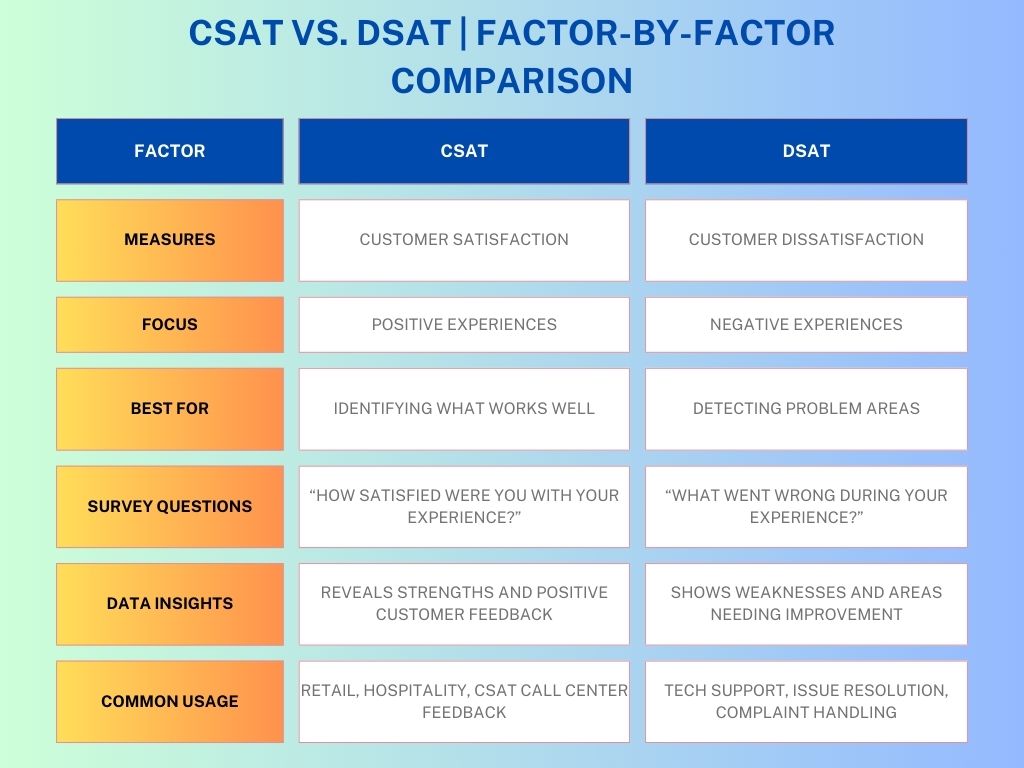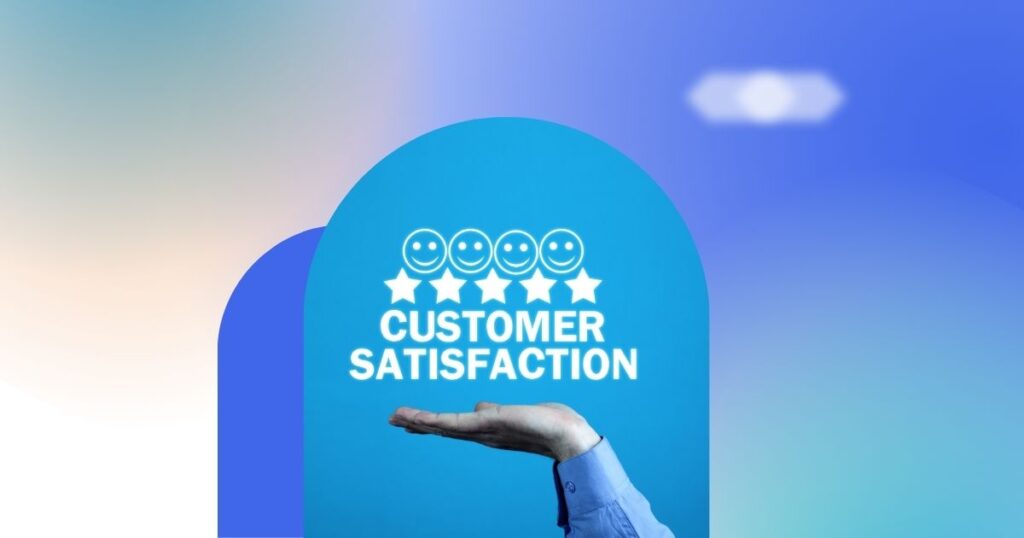Are you one of those struggling to retain customers? We often wonder what some companies are doing to have loyal customers while we struggle to retain them. Well, the answer to this is customer satisfaction metrics. The two essential metrics in the world of customer experience are CSAT vs DSAT. Businesses use these metrics to measure customers’ happiness or dissatisfaction with the service or product. Moreover, these key metrics help companies understand what they are doing right and where they need improvement.
Do you know that there is a strong connection between customer satisfaction and retention? Numerous studies have proven their strong link. For example, research shows that customer retention rates increase 5% for every 1% increase in customer satisfaction.
This highlights the importance of measuring the two key metrics to help businesses address the areas of customer dissatisfaction and enhance their overall customer experience.
CSAT (Customer Satisfaction Score) measures positive experiences, while DSAT (Dissatisfaction Score) highlights negative ones. Tracking both metrics helps businesses focus on happy clients and those unsatisfied with the company’s products or services.
Let’s explore the world of customer experiences and how they affect businesses.
What is CSAT?
CSAT stands for Customer Satisfaction Score. It helps businesses measure customer satisfaction after an interaction. What’s more? It also provides insights into how well the company met customers’ expectations. CSAT targets customer responses on a scale from 1 to 5 (on a 5-point scale), where 5 indicates higher satisfaction.
How It’s Calculated
Calculating CSAT is very easy. All you have to do is ask your customers a simple question: “How satisfied were you with your experience?” You can average the responses based on the formula given below.
CSAT Score = (number of dissatisfied responses/total responses) x 100
Typically, when customers rate 4 or 5, they are considered happy customers.
Pros & Cons of Using CSAT
Here are some pros and cons of CSAT:
Pros:
- Customer satisfaction metrics are often straightforward and can be easily grasped by both teams and stakeholders.
- By utilizing fast-response tools such as Net Promoter Score (NPS) or Customer Satisfaction Score (CSAT), businesses can receive immediate feedback on their services or products.
- Customer satisfaction measures reveal not only what aspects of a company’s service or product are performing well, but they also shine a light on potential weaknesses.
Cons:
- This approach often prioritizes immediate pleasure or gratification from a product or service rather than fostering long-term loyalty or satisfaction.
- When organizations fail to delve into the root causes of customer complaints, they miss critical insights that could help them improve their offerings.
- Emotional responses can heavily influence customer feedback, leading to skewed perceptions of a product or service.
Real-World Example of CSAT
In a call center, once the call rep has resolved the issue, companies send a post-service survey asking their customers to rate their experience. If a company sees a low CSAT score, it can train its employees and analyze the feedback where they lack.
For example, if customers frequently report long wait times, the business can optimize staffing to enhance response times.
Tracking CSAT vs DSAT ensures that businesses are focusing on their happy clients and addressing the issues faced by dissatisfied clients. Do you know that big names like Amazon and Apple use CSAT surveys to measure service quality and make improvements?
What is DSAT?
DSAT, or Dissatisfaction Score, is a metric that measures the customers’ unhappiness with a company’s product, services, or interaction. It serves as a counterpart to CSAT (Customer Satisfaction Score). This key metric focuses on negative customer experiences to help businesses identify where they lack and improve their overall experiences for their customers.
How It’s Calculated
When companies want to measure this metric, they ask their customers to rate their dissatisfaction after an interaction using a scale. The DSAT score is then determined by the percentage of customers who report high levels of dissatisfaction. For example, if 20 out of 100 respondents rate their experience as highly dissatisfied, the DSAT score would be 20%.
Pros & Cons of Using DSAT
Pros:
- DSAT highlights specific pain points that show where customers are unhappy. This allows businesses to target improvements effectively.
- Companies can reduce customer attrition by addressing issues leading to high DSAT.
- When companies start understanding customer dissatisfaction, they will work to improve their services and products. This will enhance their interactions and the quality of products and services.
Cons:
- If companies only focus on dissatisfaction feedback, they may overlook the customers’ positive feedback, which may affect their strengths.
- Dissatisfied customers are more likely to respond, potentially skewing results.
- Unfortunately, companies have to look for additional qualitative data because DSAT scores do not provide detailed reasons behind dissatisfaction.
Real-World Example of DSAT in Action
Addressing customer dissatisfaction is crucial. According to numerous studies, 91% of unhappy customers leave a brand without complaining. Therefore, businesses must identify and rectify issues before losing valuable customers.
Consider a call center aiming to improve its customer service. After every interaction, they ask their customers to rate their dissatisfaction. If many customers are unhappy with their service, the company can dig deep to find the problem and work on it to improve the overall experience for their customers. Moreover, they can train their staff to respond better.
CSAT vs DSAT: Key Differences
Understanding the difference between CSAT vs DSAT is crucial for businesses. Why? It helps companies to improve their customer experiences. While CSAT (Customer Satisfaction Score) highlights positive experiences, DSAT (Dissatisfaction Score) identifies pain points. However, tracking both metrics is crucial for businesses because it helps them understand what they are doing right and where to improve.
Factor-by-Factor Comparison
Let’s compare the two:

Choosing Between CSAT vs DSAT
Businesses often wonder, “What is CSAT?“ and “What is DSAT?“ and which one to prioritize. You must know that both are equally crucial if you are also among them and looking for the answer. CSAT targets satisfied customers, while DSAT’s meaning lies in identifying dissatisfaction.
For example, a CSAT call center might use CSAT to measure happy customer interactions and DSAT to identify unresolved complaints. A company with a high DSAT score can improve its response times or train its agents to enhance customer experiences.
Why Both CSAT and DSAT Matter
Some businesses might only focus on the positives and ignore the negatives. However, focusing only on the CSAT score may not tell the complete story. Do you know that many unhappy customers may never respond to survey and leave to join competitors?
A study found that 81% of customers would switch brands after a poor experience. Tracking both CSAT and DSAT helps companies maintain high retention and improve service quality.
Businesses can use both metrics to create a better customer experience, address the pain points, and foster brand loyalty.
Why is CSAT Important?
Here’s why businesses must give CSAT score its due importance:
- This involves systematically assessing customer satisfaction through surveys, feedback forms, and other methods of data collection.
- This process focuses on analyzing specific customer interactions that lead to positive outcomes, such as high satisfaction ratings or repeat business.
- Beyond merely measuring happiness and identifying successes, this insight offers a deeper understanding of the factors that drive customer satisfaction.
Why is DSAT Important?
Here are some reasons you should know:
- By actively gathering feedback and analyzing customer interactions, businesses can identify specific areas where their customers experience difficulties.
- A detailed mapping of the customer journey helps pinpoint where obstacles arise that may hinder the overall experience.
- Analyzing patterns in customer feedback and support inquiries allows companies to spot recurring issues that may not be immediately obvious.
When enterprises use CSAT vs DSAT together, they have a 360-degree view of customer experience.
How to Improve CSAT and Reduce DSAT?
CSAT vs DSAT are crucial metrics for understanding how well a business meets customer expectations. Are you wondering how companies can retain customers? Improving the CSAT score while reducing the DSAT score will enhance customer retention and build a positive reputation.
Businesses can create a seamless journey that increases satisfaction and reduces dissatisfaction. But how? They can enhance the customer support experience, proactively resolve issues, and offer personalized interactions. Here are some more ways to improve CSAT:
Enhance Customer Support Quality
Customer support quality is the most critical element in improving the CSAT score. Businesses looking to enhance their CSAT score while reducing DSAT must train support teams to handle inquiries.
Why is this important? Call reps often fail to answer customer queries, leading to unhappy customers. Therefore, businesses must hire trained support teams to handle such situations if they intend to meet customers’ needs.
Businesses with well-skilled support teams will have better chances of addressing various concerns, from simple queries to complex issues. This ensures that each interaction is handled professionally.
Moreover, companies can also implement AI-powered chatbots and self-service options. How will they help? These technologies can help resolve simple customer inquiries in real time. Furthermore, they will reduce waiting time and offer immediate solutions. This will gain more customers’ trust in the company, leading to more customer retention.
Proactive Issue Resolution
This is also one of the best ways to improve CSAT and reduce DSAT. This allows companies to identify and resolve common pain points before they escalate to major problems. Businesses should regularly monitor customer feedback to identify issues. When businesses address these pain points early, they prevent them from affecting many customers, minimizing potential frustration.
Predictive analytics is another powerful tool for proactive resolution. And how does it help businesses? By analyzing historical data, companies can anticipate issues and work on them to prevent them from occurring.
For example, if analytics show that certain products frequently encounter issues or customers often ask similar questions, the company can proactively address these challenges for a better experience. Companies can offer tutorials or inform customers about potential problems before they occur. This reduces customers’ chances of encountering challenges and improves CSAT and DSAT.
Personalized Customer Interactions
Personalization is key to improving CSAT and reducing DSAT. When customers feel valued and heard, they are more likely to be satisfied with the service they receive. One way to achieve this is by improving response times.
Customers today expect fast and efficient service. Long wait times or delayed responses can lead to frustration and negatively impact CSAT. By improving response times, businesses can ensure customers feel prioritized, leading to a better experience.
Another vital aspect of personalized service is offering tailored solutions. Every customer’s issue is unique, and a one-size-fits-all response may not address the root cause of their dissatisfaction.
Businesses can offer more relevant and practical solutions by taking the time to understand each customer’s specific needs and concerns. This approach makes customers feel like their concerns are genuinely addressed, boosting CSAT.
Leverage ScaleSupport for Outsourced Customer Support
ScaleSupport offers an efficient solution for companies struggling to maintain high CSAT and reduce DSAT.ScaleSupport is an outsourcing service that provides businesses with dedicated customer support teams. This allows companies to deliver consistent, high-quality service without burdening the entire in-house team.
Businesses can now leverage ScaleSupport expertise to improve their CSAT scores and minimize their DSAT score. Moreover, it ensures that customers’ issues are addressed promptly and efficiently.
Why ScaleSupport?
ScaleSupport helps companies improve their customer support operations by offering a seamless, scalable, cost-effective solution. With experienced support agents, AI-powered tools, and 24/7 availability, ScaleSupport ensures that customer inquiries are handled quickly and professionally.
Whether managing common pain points or providing personalized solutions, ScaleSupport helps businesses create a positive customer experience, leading to higher satisfaction and loyalty.
Consider a tech company facing declining CSAT due to long response times and inconsistent support quality. With ScaleSupport’s trained agents handling inquiries around the clock and implementing AI chatbots for quick responses, the company’s CSAT scores can rise within six months.
The Bottom Line
Tracking both CSAT vs DSAT is crucial for understanding customer satisfaction comprehensively. CSAT helps businesses identify and celebrate positive customer experiences, while DSAT uncovers areas that need improvement, providing valuable insight into potential pain points.
By implementing improved support strategies and personalizing customer interactions, businesses can enhance their overall customer experience.
Additionally, Scale Support Services helps address concerns more effectively. This combination ultimately leads to building lasting customer loyalty. Analyzing both metrics allows businesses to make informed decisions that drive improvements.
Ready to improve your customer support and boost satisfaction? Schedule a free Scale Support consultation today!

Dianne has extensive experience as a Content Writer, she creates engaging content that captivates readers and ranks well online. She stays on top of industry trends to keep her work fresh and impactful. She has a talent for turning complex ideas into relatable stories. When she’s not writing, you’ll probably find her with a crochet hook in hand or working on a fun craft project. She loves bringing creativity to life, whether it’s through words or handmade creations.






